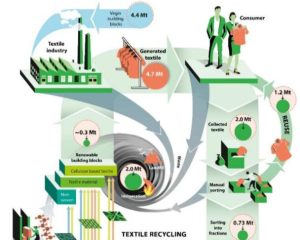
Fight to Prevent Clothing Landfills
A significant quantity of textile waste is in landfills since the fashion industry has long been linked to trends and immediate consumption. However, in recent years, a greater understanding of how this affects the environment has inspired the growth of the clothes recycling sector. Various actors in this sector, including nonprofit organizations, for-profit businesses, and government programs, are all fighting to keep clothing out of landfills and find creative ways to recycle textiles.
The Growing Landscape of Textile Recycling
The Salvation Army and Vinnies, which take clothes donations, run thrift stores, and provide clothing to those in need, are examples of charities and nonprofit organizations that have traditionally promoted garment recycling. However, for-profit enterprises have recently joined the market, providing clothes-collecting and recycling services to corporations and organizations. Examples include Textile Recyclers Australia, Upparel, and SCRGroup. These businesses have established networks of textile donation bins to make it simpler for customers to donate their unworn clothing.

Source: Shen (2021)
Government Support and Initiatives
The Australian government has taken action to support the business because it understands how vital textile recycling is. The National Clothing Product Stewardship Scheme, which attempts to decrease textile waste and enhance recycling rates, is one noteworthy initiative. Government funding has also been set aside to support the study and creation of innovative textile recycling technology. These programs demonstrate the government’s dedication to advancing the garment recycling industry’s innovation and building a more sustainable fashion ecosystem.
Challenges and Opportunities
The textile recycling sector still confronts challenges, despite advancements. Consumer education on clothes recycling and changing their purchase habits are major barriers. Many people are unaware of how textile waste affects the environment and how much of it may be recycled. Education and awareness efforts must be launched to encourage the responsible use and disposal of clothing in order to address this problem.
Consumers Education
Consumers can significantly influence how the recycling of textiles develops in the future. We can increase the lifespan of our garments and lower our trash production by making thoughtful decisions. It is easy to recycle textiles by using designated bins or by giving away unwanted garments. By doing this, we guarantee that these clothes are recycled or donated. Embracing a circular economy mindset could also have a significant impact. Clothing repaired, recycled, or upcycled reduces waste and new clothing needs. Supporting businesses that put sustainability first and offering take-back services could persuade the garment sector to use more environmentally friendly production and recycling techniques.
The most significant barrier is that consumers are uninformed of how textile waste affects the environment. Many people believe clothing is disposable and may not consider the effects of their shopping and disposal habits. Creating and carrying out significant education and awareness programs is required to address this issue. These adverts can highlight the detrimental consequences of textile waste on the environment by highlighting the resources and energy needed to make new garments and the pollution brought on by textile production and landfilling. It is feasible to influence consumers to make more sustainable decisions by emphasizing the advantages of recycling garments, such as cutting greenhouse gas emissions, reducing waste, and preserving resources.
Changing Consumer Behavior: A Path to Sustainable Fashion
The success of attempts to recycle garments depends on changing consumer behavior. A crucial opportunity is to persuade people to reevaluate their shopping patterns and choose sustainable options. Consumers can lessen the demand for new clothing by encouraging ethical consumption, lessening the need for excessive manufacture and associated waste.
Promoting the idea of a circular economy in the fashion business is one practical approach. Customers might be urged to fix or repurpose their apparel to increase the lifespan of that item. This strategy promotes innovation and individuality in personal style while also reducing waste. You can also advertise fashion rental businesses and clothing swap events to encourage a culture of sharing and reusing clothing.
Retailers and brands have a significant impact on this development. They can implement environmentally friendly methods, including recycling materials, creating take-back programs for used clothing, and being honest about their supply chains and environmental effects. Customers can feel empowered to make informed decisions and promote a more sustainable fashion industry by supporting and promoting these brands.
Developing Efficient Recycling Methods: A Call for Innovation
Creating more effective recycling techniques is another issue facing the garment recycling sector. Even though textile recycling technologies have advanced, there is still a need for innovation and investment in scalable and efficient procedures.
Recycling textiles is a complex undertaking due to the intricate blend of natural and synthetic fibers that they include. Due to their chemical makeup, synthetic fibers like polyester and nylon are incredibly challenging to recycle. The recycling process is further complicated by mixed fabrics, which combine several components.
The goal of research and development should be to develop methods for handling various textile materials. Chemical and mechanical recycling techniques that have undergone innovation can aid in overcoming these difficulties. Depolymerization and solvent-based recycling techniques chemically disassemble the fibers into their molecular building blocks for reuse. Two mechanical recycling techniques are shredding and respinning the fibers into new yarns or fabrics.
To increase the effectiveness of textile recycling, it is also essential to invest in cutting-edge sorting technologies. Artificial intelligence and machine learning-based automated sorting systems can precisely identify various textile types, easing the separation process and assuring the best possible recycling results.
Furthermore, industrial stakeholders, academic institutions, and governmental organizations must work together to promote innovation in textile recycling. Research and development projects to enhance recycling practices, produce new materials, and establish more sustainable textile production techniques should be encouraged with funding and support.
Conclusion
Due to greater awareness and government backing, the recycling of garments has seen impressive growth in recent years. To develop a genuinely circular fashion economy, obstacles remain to be addressed. We can all change how we make, use, and recycle textiles by educating consumers, funding research and development, and encouraging sustainable practices. Individual decisions have an impact, and by supporting textile recycling, we can help the fashion industry move toward a more environmentally friendly and sustainable future.




Be the first to comment